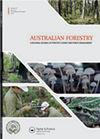斐济亚西檀香(Santalum yasi)参与式价值链研究
IF 1.2
4区 农林科学
Q3 FORESTRY
引用次数: 7
摘要
Santalum yasi(yasi)于19世纪初在斐济首次被开采,此后一直被周期性地大量收割。Yasi生产的檀香是最有价值的檀香之一,富含α-和β-檀香醇,通常符合东印度檀香(Santalum album)檀香油的ISO标准。尽管野生亚西林分现在接近商业灭绝,但它们正被斐济群岛各地迅速扩大的小农户种植所取代。对斐济的yasi进行了为期35年(1984年至2018年)的价值链研究。该研究于2018-2019年以参与式方式进行,通过采访和咨询关键价值参与者,包括yasi所有者和种植者、买家、当地买家和加工商、国际买家和加工者以及斐济政府林业部。研究的重点是主要的亚西生产和加工岛屿Viti Levu、Vanua Levu、Kadavu和Lau集团。yasi价值链的运作一直不理想,树木所有者、种植者和斐济政府的回报不高,未能发展当地的yasi石油和增值产业,直到最近,还缺乏yasi的重新种植。斐济增加yasi种植的一个持续制约因素是缺乏能够为种植者提供投资安全的切实有效的监管和贸易框架,包括法律核查(监管链),以满足市场要求并遏制非法采伐。本研究的主要发现是:(1)yasi品牌在国际市场上缺乏认可和发展,因为它取代了S.专辑,对价值链上的所有参与者产生了不利影响;(2)基于yasi的自然属性和竞争力,有机会进行品牌推广。为yasi树所有者(i-Taukei和小农户)、斐济林业部以及檀香木买家、加工商和出口商提供了改善yasi价值链短期和长期运作的建议。鉴于其高价值和不易腐烂性,yasi具有为偏远岛屿群岛的斐济社区贡献现金收入的巨大且近乎独特的潜力。斐济完全有能力发展一个具有高度竞争力和可持续性的雅西檀香产业,通过发展高质量的种植、加强治理和监管链、雅西品牌战略、发展当地增值以及与主要香水公司和身体护理产品公司合作,为树木所有者、种植者和加工商带来更大的回报。本文章由计算机程序翻译,如有差异,请以英文原文为准。
Participatory value chain study for yasi sandalwood (Santalum yasi) in Fiji
ABSTRACT Santalum yasi (yasi) was first exploited in Fiji in the early 1800s and has been harvested periodically but heavily ever since. Yasi produces one of the most valuable sandalwoods, being high in α- and β-santalols and typically meeting the East Indian sandalwood (Santalum album) ISO standard for sandalwood oil. Although wild yasi stands are now near to commercial extinction, they are being replaced by rapidly expanding smallholder plantings throughout the Fiji archipelago. A value chain study is presented for yasi in Fiji for a 35-year period (1984–2018). The study was undertaken in 2018–2019, in a participatory manner, through interviews and consultations with the key value actors, comprising yasi owners and growers, buyers, local buyers and processors, international buyers and processors, and the Fiji Government’s Ministry of Forestry. The study’s focus was on the main yasi-producing and -processing islands of Viti Levu, Vanua Levu, Kadavu and the Lau Group. The yasi value chain has been operating suboptimally, with modest returns to tree owners, growers and the Fiji Government, a failure to develop a local yasi-oil and value-adding industry, and, until recently, a lack of yasi replanting. An ongoing constraint to increased plantings of yasi in Fiji is a lack of practical and efficient regulatory and trading frameworks that can provide security of investment for growers, including legal verification (chain of custody) to meet market requirements and curb illegal harvesting. Key findings of this study are: (1) there is a lack of yasi brand recognition and development in the international marketplace due to its substitution for S. album, adversely affecting all actors along the value chain; and (2) there is an opportunity for branding based on yasi’s natural properties and competitiveness. Recommendations are provided to improve the functioning of the yasi value chain in both the short and long terms for yasi tree owners (i-Taukei and smallholder growers), the Fiji Ministry of Forestry, and sandalwood buyers, processors and exporters. Given its high value and non-perishability, yasi has major and near-unique potential to contribute cash income to Fijian communities in remote island archipelagos. Fiji is well placed to develop a highly competitive and sustainable yasi sandalwood industry that delivers greater returns to tree owners, growers and processors through the development of high-quality plantings, enhanced governance and chain of custody, a yasi branding strategy, the development of local value-adding, and cooperation with major perfume houses and body-care-product companies.
求助全文
通过发布文献求助,成功后即可免费获取论文全文。
去求助
来源期刊

Australian Forestry
FORESTRY-
CiteScore
3.70
自引率
4.80%
发文量
15
审稿时长
>12 weeks
期刊介绍:
Australian Forestry is published by Taylor & Francis for the Institute of Foresters of Australia (IFA) for scientific, technical, and professional communication relating to forestry in the Asia Pacific.
 求助内容:
求助内容: 应助结果提醒方式:
应助结果提醒方式:


